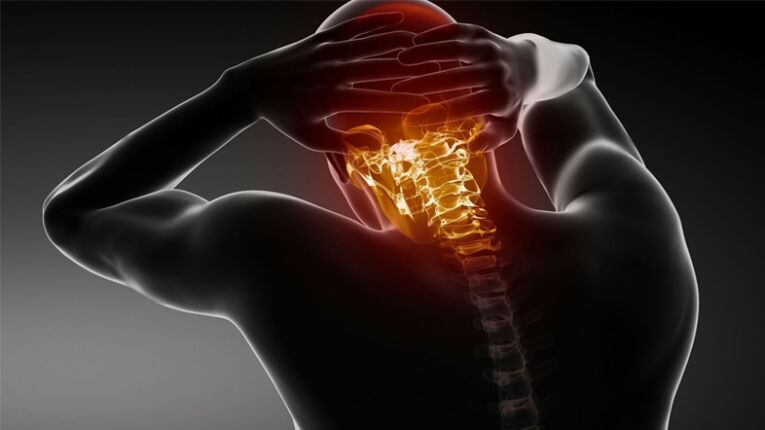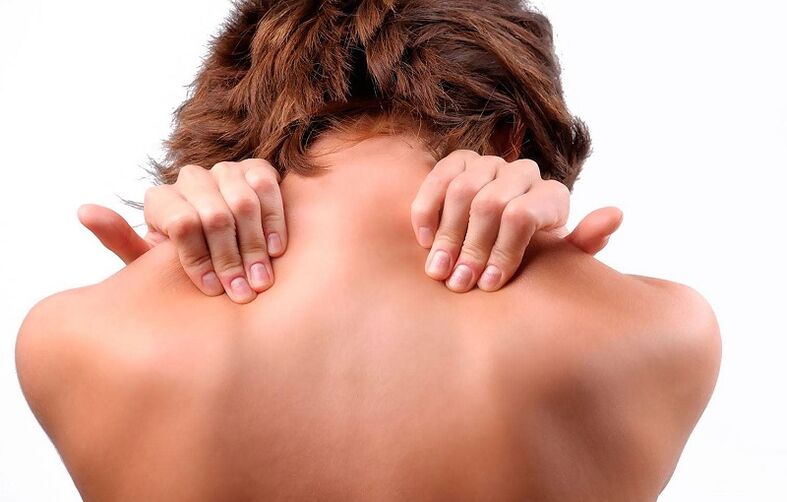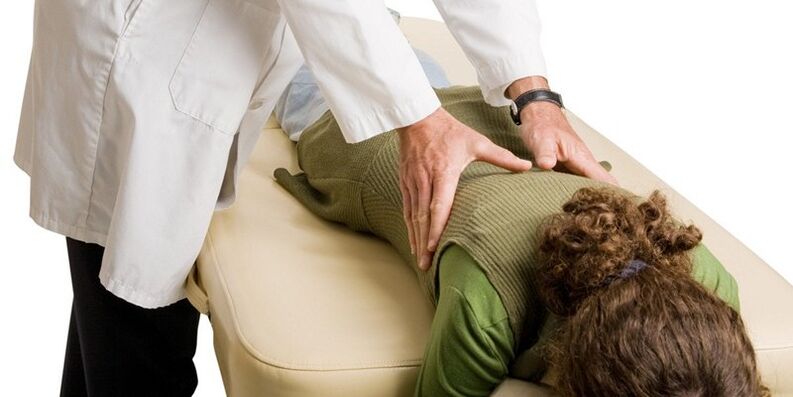
Osteochondrosis is often referred to as dystrophic changes in the intervertebral disc in medicine.This problem can occur in people of any age.Disc dysfunction can cause many unpleasant related health problems.Therefore, it is necessary to pay attention to the signs of cervical osteochondrosis immediately and then start treatment immediately.
general description of disease
The cervical spine consists of 8 pairs of ganglia and 7 vertebrae.Typically, cervical osteochondrosis develops due to the degeneration of the intervertebral spinal cord into vitrified tissue.At the same time, pathological changes can negatively affect nerve fiber endings as well as important blood vessels.This pathology mainly affects the eighth and seventh vertebrae.

The symptoms of cervical osteochondrosis can easily be confused with other conditions.During the illness, you may experience headache attacks and experience neck discomfort.Symptoms of cervical osteochondrosis also include dizziness, nausea, and blood pressure problems.In most cases, this disease is confused with vascular and cardiac diseases.
It is worth noting that against the background of vertebral lesions, patients often suddenly lose consciousness, feel shortness of breath and sometimes even numbness of the tongue.Therefore, the symptoms of cervical osteochondrosis must be seen to be believed.
This unpleasant disease is mostly diagnosed in people over the age of 30.This is explained by the specificity of the position of the human bones and the constant dynamic and statistical loading.But it is worth noting that this disease has recently been rapidly affecting younger people, so even in adolescence, symptoms of cervical osteochondrosis can be observed in both women and men.
disease cause
The development of this unpleasant disease is influenced by pathological and physiological processes.All of these are closely related to each other, and in medical practice, experts often consider them together.
As for physiological changes, they are caused by irreversible age-related processes that occur in the cartilage of the spine.These changes are located in the central area of the disc.The physiological symptoms of cervical osteochondrosis in women and men are manifested by the compression of the dental pulp by certain fibrous tissues.When nerve endings become irritated, patients begin to feel discomfort.
Pathological changes are processes in which the area of inflammation extends beyond the area of cartilage tissue.Pathological symptoms of cervical osteochondrosis in women and men can cause severe irritation of the nerve ending area and compression of blood vessels.This change may occur in the context of malnutrition resulting from a sedentary lifestyle.In addition, pathological changes are frequently observed in adolescents and middle-aged adults.
It is important to note that symptoms of cervical osteochondrosis in women and men may, in some cases, resolve on their own or manifest as short-term episodes.The human body has many protective and compensatory functions that, over time, are able to neutralize these pathological changes in cartilage areas.

triggering factors
The following factors may trigger the development of this unpleasant disease:
- Being overweight.
- Lack of sustained physical activity and sedentary jobs.
- Stressful conditions and nerve stress.
- The patient's body is often in an awkward position.
- Injuries to the back of the head and neck.
- Low temperature.
It is also worth noting that symptoms of cervical osteochondrosis in men and women can be due to congenital abnormalities as well as autoimmune disorders.
Main features
It should be noted that cervical osteochondrosis is sometimes not accompanied by pain in a specific part of the spine.The clinical manifestations of this disease are often unclear.The main symptoms of cervical osteochondrosis in men and women include dizziness, sudden changes in blood pressure, and migraines.However, it is necessary to highlight the symptoms that require urgent hospitalization:
- The headaches worsen, along with a worsening of overall health.
- Loss of mobility and numbness in shoulder girdle or facial muscles.
- Impaired coordination of movements.
- Unconscious.
When considering the signs and symptoms of cervical osteochondrosis, it should be noted that pain often radiates to the upper extremities and shoulder girdle.One of its distinctive features is the pain syndrome, which is paroxysmal in nature.Basically, this pain occurs after getting up, when laughing, during sudden movements, sneezing and coughing.
Answering the question of what symptoms of cervical osteochondrosis trouble patients, it should be noted that in the initial stages of the disease, the pain subsides quickly, a tightness in the neck often occurs, the muscles weaken, and the skin loses sensitivity.
If the sixth vertebra is affected, you may experience pain in your thumb.If the changes affect the seventh vertebra, then the pain will appear in the middle finger.

In general, symptoms of osteochondrosis of the cervical and thoracic spine in women appear later than in the stronger half of the human population.
Relationship with other diseases
Manifestations of signs of cervical osteochondrosis in men and women may be related to other diseases.For example, experts have long established a link between blood pressure and osteochondrosis of the cervical spine.This unpleasant disease is characterized by drastic changes in blood pressure throughout the day, and persistent high blood pressure is not associated with this disease.
Increased pressure during osteochondrosis may be accompanied by pain in the arms, chest, legs, and head noises.Symptoms of cervical and thoracic osteochondrosis include decreased skin sensitivity in the collar area.Sustained stress and prolonged exposure to uncomfortable positions can cause elevated blood pressure.
Dizziness and cervical osteochondrosis occur due to severe pain, cerebral circulation disorders, and nerve signal transmission.This can also occur due to problems with the vestibular system.Initial symptoms of cervical osteochondrosis include nongeneralized dizziness.In this case, the patient cannot feel the rotating object but has severe nausea.The patient has difficulty maintaining a standing position.
It is important to note that during dizziness you should see not only a neurologist, but also an ear, nose and throat specialist, so that this specialist can rule out the presence of pathologies in the nasopharynx.
Most often, osteochondrosis is accompanied by headache.It occurs due to vasospasm, increased intracranial pressure, and compression of nerve endings.Pain can manifest itself in different ways, whether it's a dull ache or a throbbing pain.
During osteochondrosis, headache attacks are similar to the sensations experienced during elevated blood pressure, heart attack, angina, and stroke.
During osteochondrosis, panic attacks may occur against the background of disorders of cerebral circulation.Patients may experience physical discomfort and unfounded fear.The duration of this attack can range from a few minutes to an hour.Attacks may occur several times a day.Additionally, panic attacks are accompanied by constant tearing, light-headedness, lethargy, and feelings of apathy.If a patient has a severe episode, they will need to see a psychiatrist regularly and take sedatives.

This disease can lead to depression and fear in the context of constant pain and forced changes in normal lifestyle.
diagnostic methods
Most people with osteochondrosis experience pain in the back of their head, arms, and chest.The disease's vague description makes initial diagnosis very complicated.Additionally, uncontrolled use of analgesics can prevent timely diagnosis.Patients who experience no pain feel completely healthy.As a result, it is too late for people to seek medical help when irreversible processes have already begun in the joint tissue of the neck.
Diagnosis requires an X-ray, after which the r signs of cervical osteochondrosis can be seen.After the X-ray, the patient will undergo a course of treatment.If the R sign of cervical osteochondrosis is unstable, the following symptoms will occur:
- Angular deformity of the affected segment.
- The vertebrae shift sideways, backward, or forward.
- If the vertical axis deviates by more than 2 mm within 2 vertebrae, it indicates the presence of a lesion.
Of note, radiography is an ineffective diagnostic method, especially in the final stages of osteochondrosis development.
Additionally, patients may be given magnetic resonance imaging during diagnosis.MRI signs of cervical osteochondrosis are helpful in diagnosing patients.During a tomography scan, experts can see the bone structure, herniated discs, their direction and size.If MRI signs of cervical osteochondrosis are detected promptly, the disease can be quickly overcome.
A solution that is as effective as MRI is computed tomography.This procedure allows you to identify CT signs of cervical osteochondrosis.Additionally, it is worth noting that computed tomography can better identify the presence and size of hernias.

drug treatment
After diagnosis, a specialist will diagnose the patient and prescribe appropriate treatment.Medication is designed to combat pain and inflammation.Medication can restore normal activity and circulation.The main drugs used to treat this disease are as follows:
- Various analgesics in the form of injections and tablets used to relieve pain.
- Steroids and non-steroidal anti-inflammatory drugs.
- Chondroprotective agent that restores cartilage tissue.
- To relax your muscles, you need to take a muscle relaxant.
- Also, a prescription vitamin complex, which should contain all vitamins B, C, and D, as well as ascorbic acid and retinol.
- For topical use, products are available in ointment and gel form to improve blood circulation, relieve pain and spasms, provide pain relief, and provide warmth.
You should also note that the vitamins contained in food are not enough to treat this unpleasant disease.Therefore, complex preparations can be used.
If you have cervical osteochondrosis, it is also recommended to take medications that can improve cerebral circulation.Taking such drugs is a mandatory part of the treatment of this disease.
Operation
Surgical intervention is rarely used to treat osteochondrosis.However, if paralysis of the upper limbs is observed, the patient cannot be without surgery.Surgery is also required if the patient has cerebral edema.
complementary therapies
Massage is recommended as an additional therapeutic measure.Experts also recommend the use of manual therapy in the form of rapid translational movements.Very effective methods include: dose traction, relaxation techniques and acupuncture.
treatment at home
In conjunction with medical treatment, non-traditional recipes can also be used.At-home treatment includes regular practice of special exercises and techniques, as well as the use of certain orthopedic devices.Traditional medicine recipes can be used as maintenance treatment.

To remove tension from your spine, reduce stress and strengthen your neck muscles, use a Shants collar.The neck and head are fixed in a certain position.As a result, you can overcome insomnia and prevent the development of pathological changes.This collar must be worn for a few hours before going to bed.Under no circumstances should it be used throughout the day.
Self-massage can relieve pain and cramps.During this procedure, it is recommended to apply additional ointments, which can improve blood flow.The massage is performed in a sitting position, and the posture should be comfortable and relaxed.During this time, perform stroking and circular rubbing.When performing this type of surgery, not only the neck is affected, but also the shoulder girdle.
It is important to note that if you have cervical osteochondrosis, it is prohibited to use any type of heating, except in saunas or steam rooms.
take a special bath
You can get rid of pain and inflammation with the help of medicated baths.This type of surgery helps relax the spine.Bathing should be done every other day, and the course of treatment should be carried out 15 to 20 times.Bath recipes:
- Mix 300 g of mint and chamomile.Prepare the herbs in 10 liters of boiling water.Let it brew for 2 hours, then strain.
- Take 40 grams of lemon balm, equal amounts of birch and mint leaves.The resulting composition is brewed with 12 liters of boiling water and allowed to brew for 2 hours.After that, strain the broth and pour it into the tub.
- To prepare a sage infusion, you need to take 300 g of sage ingredients and 5 liters of boiling water.Brew the medicinal solution for 2 hours, drain it and then use it.
For oral administration, you can use yarrow infusion.This way, you can quickly get rid of inflammation, pain, and cramps.To prepare the infusion, you need to take 230 ml of boiling water and 6 grams of yarrow.Let the broth simmer in an airtight container for an hour.The finished product is taken three times a day, 15 ml each time.
A solution consisting of 1 liter of water and 15 grams of sea salt is very effective in combating osteochondrosis.The brine solution must be boiled and then must be completely cooled.Soak a natural fabric in the resulting composition and apply it to the back of the neck.
possible complications
If diagnosed promptly and treated correctly, there should be no complications from the disease.Otherwise, quite serious pathological processes may develop, which may lead to future disability.Cervical osteochondrosis may harm human health.The main hazards include the following:
- In vertebral artery syndrome, organic and functional changes caused by disorders of cerebral circulation are observed.
- Arrhythmias and hypertension.
- Upper limb muscle atrophy, weakness, and numbness.
- Formation of hernias and protrusions.
- Neurological disorders.
- Ventricular septal defect.

Take preventive measures
Preventative measures for osteochondrosis include the simplest measures that, if performed regularly, can prevent serious health problems.Prevention is especially important for older adults and people who live a sedentary life.To prevent the development of osteochondrosis, it is necessary:
- Take a hot bath for at least 10 minutes every day.
- Go to a sauna or hammam regularly to eliminate neck tension and spasms.
- Only sleep on special mattresses and orthopedic pillows.
- When working sedentary, warm up for at least 5 minutes every hour.
Experts also recommend swimming, yoga, aerobics and special gymnastics to strengthen the neck muscles.
Patient testimonials
Reviews of treatments for cervical osteochondrosis indicate success if medications are combined with traditional medicine.Bathing with sea salt is very effective.But for successful treatment, it is necessary to seek expert help as soon as the first symptoms of the disease are detected.

























